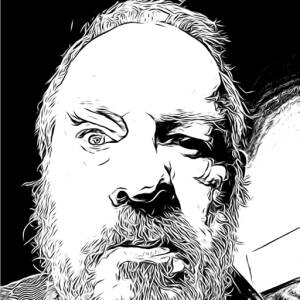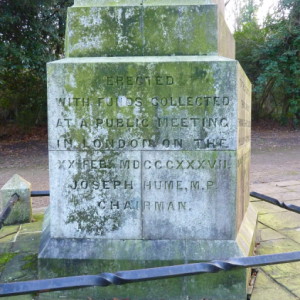You say it's to martyrs
I came across this obelisk in Nunhead cemetery, South London. It is dedicated to the Scottish Political Martyrs and is dated 1851. Sadly it meant nothing to me so I Googled it and discovered what is, to me as a non-historian, a fascinating story.
( A digression. A long time ago I attended a talk by a politician about the new University for Industry. He said that it was a strange title because it was not a university and it was not run by industry. A wag in the audience brought the house down by shouting “And there aren’t four of them!” Well the Nunhead monument turned out to a be a bit like that)
The full story of the martyrs can be read in Wikipedia
The five men commemorated – Thomas Muir, Thomas Fyshe Palmer, William Skirving, Maurice Margarot and Joseph Gerrald - were imprisoned for campaigning for parliamentary reform under the influence of the ideals of the French Revolution. Specifically, their support of Palmer's 1793 address that advocated universal suffrage and annual parliaments was considered incendiary The five were accused of sedition in a series of trials in 1793 and 1794, and sentenced to terms of penal transportation in the British colony of New South Wales.
Only Palmer and Margarot served their full 14-year sentences and were released. Palmer remained in New South Wales and established a thriving beer-brewing operation near Sydney Cove; he died of a fever on a trading voyage back to England. Margarot departed the colony when his sentence expired, and was the only "Scottish Martyr" to return to the British Isles.
Muir escaped in early 1796, stowing away aboard an American ship and ultimately making his way to revolutionary France where he died on 26 January 1799. On 16 March 1796 Gerrald died in Port Jackson, from tuberculosis exacerbated by a weakness brought on by excessive drinking. Skirving died three days later from either dysentery or an overdose of laudanum.
So far the story is shocking – martyred for supporting universal suffrage! – but straightforward. However:
· Only two of the martyrs were from Scotland
· They were not martyrs in the traditional sense in that they were not executed (Nor were the Tolpuddle Martyrs of course)
· None of them are buried in Nunhead
· This is one of two memorials
In 1837 the Radical politician Joseph Hume MP initiated a plan to erect a monument to the five men. Hume chaired a London-based committee to raise public subscriptions in support of the monument and settled on its location being in Edinburgh.
The Political Martyrs Monument is located in the Old Calton Burial Ground on Calton Hill, Edinburgh. It is a 90 ft (27 m) tall obelisk on a square-plan base plinth all constructed in ashlar sandstone blocks. The foundation stone was laid by Hume on 21 August 1844, with 3,000 people gathered for the occasion.
Inscriptions include:
"I have devoted myself to the cause of The People. It is a good cause—it shall ultimately prevail—it shall finally triumph. Speech of Thomas Muir in the Court of Judiciary on the 30th August 1793.
I know that what has been done these two days will be Re-Judged. Speech of William Skirving in the Court of Judiciary on the 7th January, 1794."
Clearly this was not enough for Hume. Using the remaining money gathered at a public meeting in 1837, he initiated the construction of a second monument at Nunhead Cemetery in London. With a foundation stone inscribed 1851, the monument stands at a mere 33 ft (10 m) high but is still impressive.
Inscriptions say:
Condemned in Scotland AD MDCCXCIII-IV (1793-4) to transportation for advocating with fearless energy the principles of Parliamentary reform
“The experience of all ages should have taught our rulers that persecution can never efface principles” “Individuals may perish but truth is eternal” Gerralds defence
For context you can read about the Society of the Friends of the People Society. The gist of it is that William Pitt was desperate to avoid something like the French Revolution happening here.
You can see the other sides of the monument in Extras. The eagle-eyed/numerate amongst you will realize that there are five sides – a fact that I failed to take in when taking the photographs! I presume that the designer intended to symbolize the fact that five men were involved. (Can any Scottish Blipper tell me how many sides the Edinburgh monument has?)




Comments
Sign in or get an account to comment.


